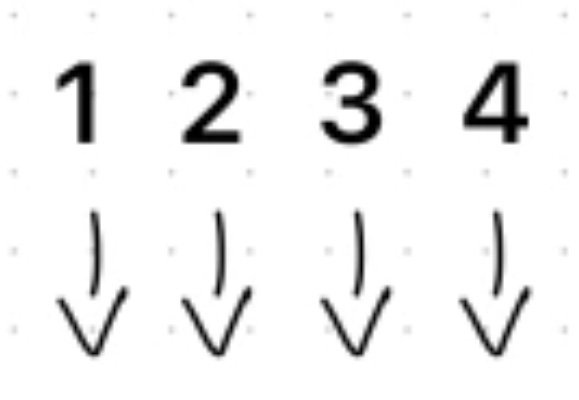How do I improve my guitar strumming?
5 ideas to help you on your way…
I. Start with ‘down’: It’s much easier to play ‘down’ strums than it is ‘up’ strums for most people in the beginning. Master playing evenly-spaced down strums first. Count 1 2 3 4 repeatedly (at a slow to moderate speed) and as you do so play a down strum as you say each number (as below)

This will build your coordination. If you can do this easily, try tapping your foot as you say each number as well.
Aim to get all 4 strums ringing out at the same volume as each other. Practise playing them loud. Practise playing them quiet. This will give you a sense of the control you can develop to vary the volume of your playing.
2. Muting: Practise your strumming by muting the strings with your non-strumming hand. You can do this with the simple ’down’ strum I mention above or a new rhythm you’re learning for a song.
Firstly, ‘muting’ is a technique where you lay your (non-strumming) fingers flat across the strings without pressing down. This creates a percussive sounds and it stops the strings from ringing out. I have a video demonstration of this here.
In this context it means we can focus on just using the strumming hand, learning the rhythm and technique without having to also think about pressing a chord down. Sometimes it’s helpful to break things down into chunks. We mute the strings with our ‘chord’ hand and strum the rhythm with our rhythm hand.
3. Stay on one chord: Now that you’ve managed to get your head and hands around your new rhythm using muted strings introduce a chord. Keep it simple. Before thinking about playing 3 or 4 different chord changes with your new rhythm pick one chord eg Em and hold it down. Play the rhythm with your strumming hand continuously holding Em down. Are all of your strings ringing out clearly? Once you feel like you’ve got the hang of this add in a second chord eg A, and then a third eg D.
4. Introduce ‘Ups’: ‘Up’ strums feel more clunky, jarring, less smooth than ‘downs’ so often people avoid them or think they can’t do them. The only way to make them feel as effortless as a down strum is to practise them. Aim to make your ‘up’ strums feel as smooth as your ‘down’ strums. Pick a rhythm to learn that includes ‘up’ strums eg
D DU D DU
D=down U=up
5. Change your pick angle: When strumming down try and angle your pick downwards (see photo)

Downward pick angle
when strumming up angle your pick upwards (see photo)

Upward pick angle
If you’re strumming with your fingers and not using a pick do the same. This angle change comes from your wrist. It helps to make the string contact feel much smoother in both directions.
Final thoughts…
Start slow: The main thing you want to aim for is an even, consistent and correct rhythm. It really doesn’t matter how slow this is as you get to know it in the beginning. The more accurate you play it slower, the more accurate and cleaner it will be as you speed it up. Try different picks: Picks that are thinner and more bendy tend to feel easier to strum with. Maybe try one that has grips on it so they’re less likely to spin round in your fingers. Different materials sounds different too. Get to know what you like by trying picks out of different thicknesses. If you’re strumming with your thumb or fingers practise using the skin side and the nail side to get different tones.
Rinse and repeat.
Repetition is key.
Of course, all of this works much more effectively if you’re enjoying it so have fun!
See you next time.
Jo


0 Comments